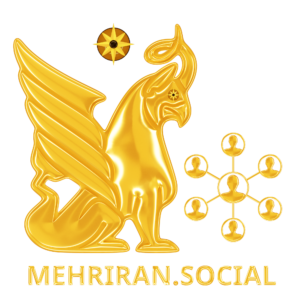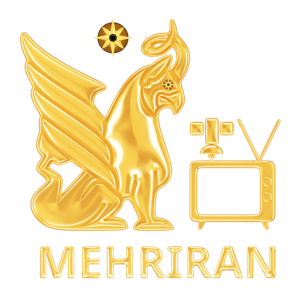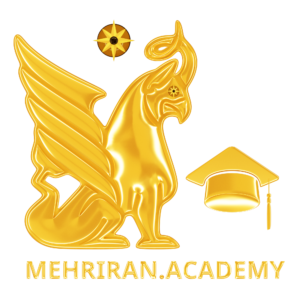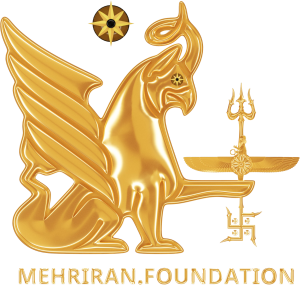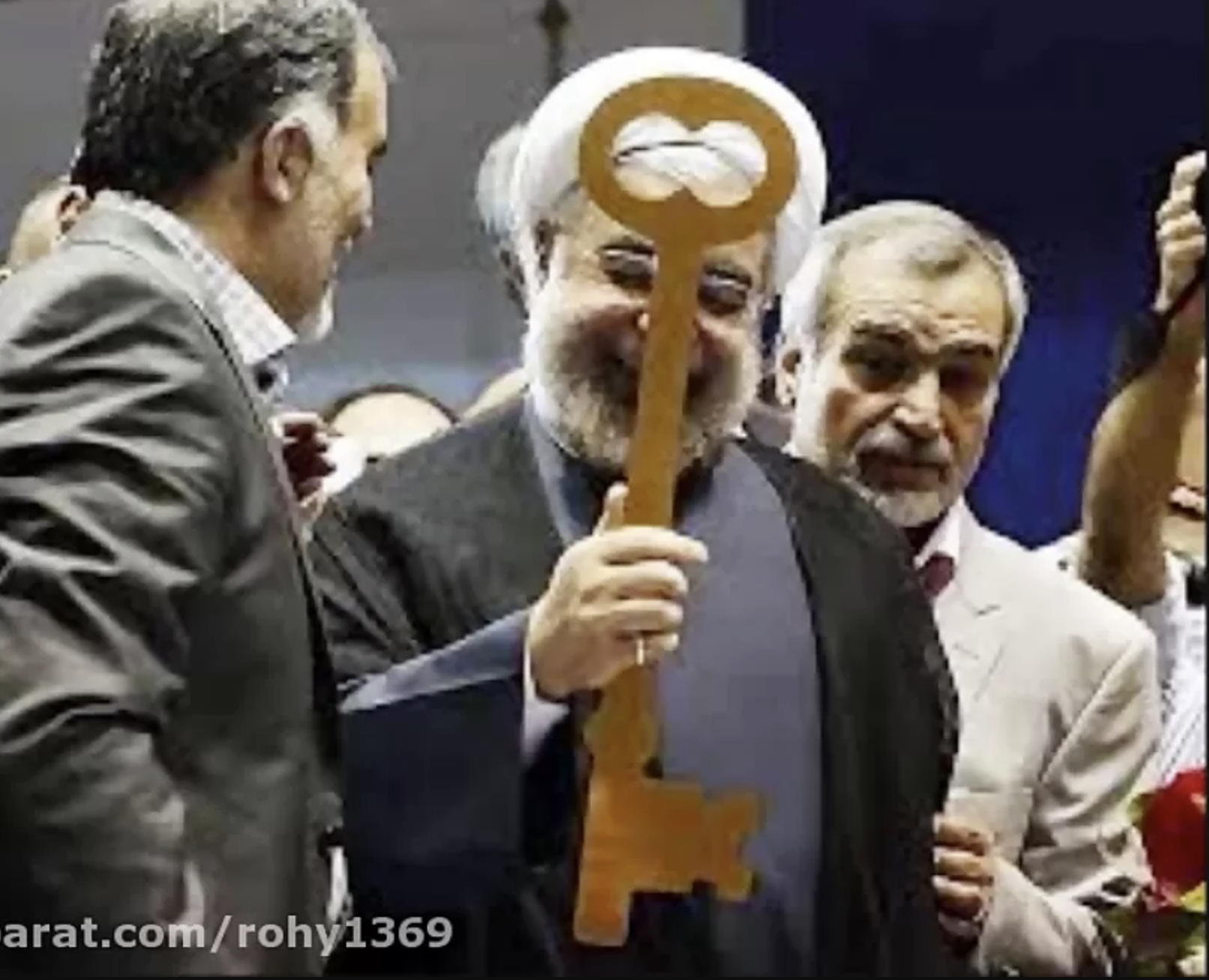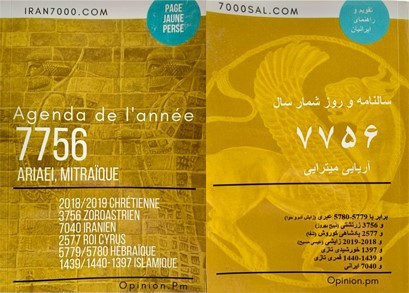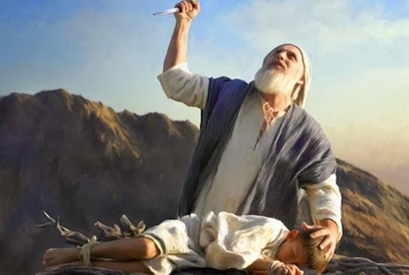NOTICE: If you are not viewing this site in Persian, the content on this page may have been automatically translated using Google Translate and may have some inconsistencies.
NOTICE: If you are not viewing this site in Persian, the content on this page may have been automatically translated using Google Translate and may have some inconsistencies. Dismiss
Menu
16 February 7759 Mitra (15 February 2021)
(This article has been published in the Iranian Journal of Zoroastrian Emmerdad in 2009)
the writer: Dr. Reza Hazli (Kay Ashkan Ardalan Afshar Naderi)
Part I
Importance of Line or Alphabet
The emergence of the alphabet, or the secretariat, or numbers has become color in the course of time, and people and tribes and groups and scientists have each considered this subject according to their own knowledge. Some of them have taken the roots of Dibira and numbers to heaven by way of ignorance and hard thinking, while others of ignorance have taken it to Egypt or the land of Babylon. But since they are all based on the same foundation, and that is not knowing the logic and the roots of making alphabets and numbers, they have misled. Surprisingly، in the best universities in the world، they do not have the desire to open this mystery and easily pass by the legends. The scientific view about the origins of the construction of the secretariat and numbers has not been extended and is hardly under the burden of batch and group thinking. But what is the point of this war and war؟
The secretaries and numbers are undoubtedly among the greatest innovations of the people and the most fundamental innovation of mankind to advance knowledge and reach ideas from people to other people in the span of time and history. These signs have been created by the people of the past and have given them to the people of the future. The Secretary، along with those numbers، are among the greatest achievements of humanity. In everyday life, from roof to evening, we are always dealing with alphabets and figures in various places. We look at our watch as we open our eyes in the morning and repeat it several times a day. Even if we don’t have a scientific work، we don’t need to be teachers or students or students، we need alphabets and figures for everyday tasks، for reading news for administrative tasks، etc. If in the old days we wrote alphabets and digits on paper، leather and stone، today we type them on our smartphones or computers. The notion that we can transmit our thoughts without the use of alphabets and numbers is completely void. Today، in the technique of links (communication technology)، three great innovations of the people of the world are mentioned، the first of which is the secretary and the numbers (alphabet and figures) the second is the art of printing and the third is the same computer and technology (technology). It، the editor and numbers (alphabet and figures) have a special place because they are more fundamental، and other communication technologies all depend on alphabets and numbers when the reverse is not necessarily true and the number and the editor’s dependence on printing and computer technologies is not so vital. Human history begins when the art of writing was created and the alphabet was created، and before that، even though humans lived for thousands of years، but not recording history، those human pasts have been mired in myth and ambiguity. The importance of alphabet and figures has always been debated in the history of the inventor and the logic of its invention، and since the logic of the invention of the alphabet has been a mystery and no one has understood it، false assumptions have always been made and based on these false assumptions، mythical theories have emerged one after the other. In the 20th century، for the first time Iranian mathematician and historian، Zabih Behrooz discovered the logic of the invention of lines and alphabets of the world by examining the history of various world lines، especially the most complete ancient line of the world، which is the line of religion of the Avestan Secretary، and then with further examination in the historical books he found plenty of evidence for his theory and published them. In this book, the author attempts to generalize and expand the theory of the day, and with edits and modifications in Zabih Behrouz’s research, two new theories about how the alphabet and digits are spread known as the “expansion from the north” theory and the other “Alphabet dynamics” theory about evolutionary and evolutionary view of the alphabet. But first of all، we must examine the current and prevailing theories about the invention and development of the alphabet and take a look at the structures and writing systems in contemporary linguistics to better understand the world’s alphabetical systems and structures. But what are the structures and systems of writing in contemporary linguistics and what are the shortcomings and inaccuracies in it؟
Structures and Writing Systems
Today’s linguistic knowledge divides the writing structures into three groups:[i]
- Phonetic system
- Semantic or semiotic structure
- The Glottographic System

Writing Structures in Linguistics[ii]
In the phonetic structure، which is the most logical writing structure in the world today، for any phonetic is considered a vowel، but the relationship between the sound and the watt is the barrier in the contractual barrier. For example، why you should use “t” for the “t” and not “m” is explained as a convention. Of course، a contract that emerges from the heart of history and from the heart of Rome، Greece، and ancient Phoenicia، but there is no logic for this contract. The ancient people themselves were unaware of the logic of this great innovation، and nowhere did they mention it in their works. In any case، the IPA (International Phonetic Alphabet) or universal phonetic alphabet and other standards like it is a writing structure.
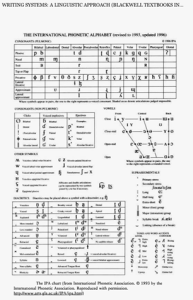
An example of the Universal Phonetic Secretary[iii]
The word is not the word of the word, but the meaning, the meaning, and the meaning. The oldest example is the hieroglyphic writing that is seen in Sumer (Caines Gale) and ancient Egypt، and the modern example is the work of Charles Bliss in the last century. This independent writing structure of various languages with special symbols and illustrations conveys meanings. For example, in order to convey the “car” or “house” in Charles Bliss’s writing, drawings such as the shape of these two concepts are drawn to convey to the reader through the form and depiction of these two concepts. Charles Bliss worked hard to find a universal structure for writing that all peoples of the world could read and understand only through concepts، independent of their language. However، this method received little attention due to structural tears and semantic constraints and ignoring the value of “ava” in writing like the ancient hieroglyphic example.
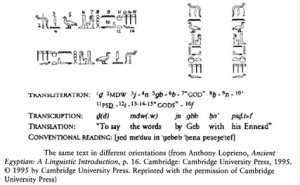
An example of Egyptian hieroglyphic line, although its structure is semantic, some phonetic structures have also been found in its modern species.[iv]

An example of a Bliss line that fits into a chordial or semantic structure.[v]
In classical linguistics، the third branch of writing structures is the glottographic method. This branch itself is divided into many sub-branches and encompasses almost all the methods of writing by different people except the first two structures. Classical segmentation classifies this structure into two subcategories: phonographic and morphographic. Phonetic units such as phonemes and syllables are written، so this group is divided into two subgroups of syllables (Moraic and Phonemic). Examples of languages in which syllables are written are Japanese. But the most advanced form of phonology is the phonograph whose genesis has made a great advance in the history of human knowledge and culture. Among the oldest examples of such writing can be the religion of Avestan and Greek and Phoenician secretaries، and its new examples are the Persian alphabet، Urdu and Latin. In this method، for each phoneme، a letter (letter) is used. But in morphetype each character or watty is used to The Owl is coming back. Chinese and Sumerian languages are written this way.[vi]
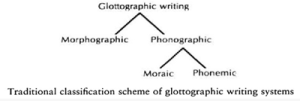
Method (structure) of linguistics and its branches[vii]
Appearance and origin of the line
As mentioned above, the best way to write is the simplest and most logical way of writing. How and when and when the people of this world are disputed. Each of them is a group of people who are trying to write their own book. But all of them and contemporary linguistic knowledge fail to grasp the secret of writing. Except in the literature of ancient Iran, nowhere in the ancient literature of the various people spoke about the first constructor and logic of making the secretaries and numbers. Surprisingly, when people have walked on the moon and cracked the nucleus of atoms, this mystery has been sealed. Is this a difficult thing to resolve، or is it a dark religious motive behind it؟
Contemporary linguistics and archaeology ascribes the oldest examples of writing to Sumer and the oldest transonic examples to Phoenicia. Aside from the fact that any archaeological discovery disturbs the foundations of these theories، the logic of this contemporary science is too weak to express the origins and origins of writing. For example، in archaeological discoveries in Jiroft، Kerman in southern Iran، older writing samples from Mesopotamia have been obtained. And they shall be in the midst of ten thousand years. This great discovery، made by Professor Joseph Majidzadeh، has really changed the history of the beginning of human urbanism. Or similar examples in the Sindh valley، which is also part of the domain of ancient Iranian urbanism and the Iranian plateau، have presented the theories of Mesopotamian civilization with a great challenge. Another example is the civilization of Merv، its scientific name is Bacteria-Margiana civilization.[viii] It is located in Iranobech، or the beginning of the Iranian land، located in Central Asia.
This vast archaeological site was created by the Greek Russian archaeologist Victor Ivanovich[ix] It was discovered that the area of civilization is the Bronze Age and its various layers are from 3،500 to 5،000 years old، and in this area samples of the line have been obtained. The Stone Age parts of the adjacent archaeological area that are known as the Anu Civilization Sphere are from 7 to 9،000 years old. It is worth remembering that the civilization of Sindh and its ancient layers are also from five to seven thousand years old، and it is amazing that ancient examples of writing have been obtained in this civilization as well. Today, other civilizations of Jiroft, Sindh valley and Iranovich, or the same archaeological area of Bacteria-Margiana, are also standing if not higher beside the civilization of Mesopotamia. All of these civilizational areas were based on the writings of Avesta in Iranovich or the Aryan (Indo-Iranian) families created them on their way to Nimroz (south). Also in the western parts of the Iranian plateau there are very ancient stone age civilizations that sometimes date back to fourteen thousand years ago، such as the Ganj civilization of Kermanshah Valley in Iranian Kurdistan and the Gobeklitappeh archaeological area[x] In the name of Anatolia (present-day Turkey). The Gobakli-Tepe archaeological area، which dates back to the tenth millennium BC or twelve thousand years ago، is the oldest settlement of humanity and ritual monuments left from the Neolithic era. Also, the civilization of the treasure in Kermanshah valley with ten thousand years of history and the brilliant civilization of Anu in Khorasan or Iranovich Avesta with the same ten-thousand-year history are examples of the urbanism and culture of the ancient country of Iran. Although in Stone Age civilizations there is no example of writing or writing، in almost all Bronze Age civilizations some form of writing or special marks have been obtained. Samples of lines and special marks in the field of bacteria-margiana archaeology in the third millennium BC in the first Aryan or Iranovich country were obtained based on the text of Avesta book. in its concurrent civilizations in the more southern parts of the Sindh civilization[xi] the Harapan Civilization[xii] And the civilization of Jiroft has also obtained written and written examples. Here, I refrain from a detailed description of these civilizations and other examples such as the urbanism found in Kashan and the Burnt City of Sistan and examples such as Gilan, Etvrpatgan, Balkh, Sogdian and the brilliant civilization of Zivyyeh near Saqaz (Saqqez) in Kurdistan, which is out of the capacity of this writing, and I only mention the ancient “Anu civilization” in ancient Iranovich, which is unknown to many. Around the ancient city of Merv excavations were carried out by Pompli and ancient civilization traces appeared. With the help of geological knowledge and consideration of the climate، Pompelli considered civilization to be eight thousand years before the birth of Christ. This is the land of the Ark of the Covenant، or the Ark of the Covenant، or the Gospel of Revelation. The findings of Pompelli indicate that some people (ancestors of Iranians) have left relics of their own in the eight thousand years before the birth of Christ or in another language around 10،000 years ago near Merv in Iranovich. They knew about buildings، agriculture، irrigation and pottery. Cattle and sheep and cattle and cattle were used to breed cattle. Copper, lead, and brass were used in industrial work and could pierce hard stones like turquoise for beads of necklaces and bracelets. Many small statues and statues, knives, daggers, vases and copper stone dishes have been found.[xiii] Another interesting point of view that has been underestimated is the origins of ancient Sumerian civilization. This is due to the fact that the oldest examples of cuneiform and human morphology have long been considered Sumer. Even Professor Waddell، a professor at the University of London، found Egyptian hieroglyphics in Sumerian script.[xiv] Although the works of civilizational slopes of the Iranian plateau such as Kerman Jiroft and Pakistan’s Sindh Valley strongly challenge the authenticity of Sumerian works، Sumer or Cain Gil is one of the cradles of human urbanism. Surprisingly، in many works and even academic works، they mix the names of Sumer and Babylon، and use the word Babylon for both of them، and apologize wherever they are criticized and call it “misdemeanor.”
The Babylonians were a Semitic family and emerged a few thousand years after the Sumerians، and their work was to recount the same culture، art، and literature of ancient Sumer. The Sumerians، who called themselves Kines-gili and who had their roots from the people beyond the mountains (Iran) and had migrated from somewhere around Gilan to Mesopotamia، played a major role in the city that later became known as the civilization of Babylon and Mesopotamia. The role was so great that the Babylonians were left with nothing but repetition. The Sumerians used to call it “Dupu” or inscription، and in ancient Hindi the word “Li Pay” also came to mean the same thing. “D” is more in the Aryan dialects of Jorasani (eastern) Dialects of “L”. In ancient Persia, the DP is the same.[xv] It is worth noting that the “Manners” and “Manners” are all based on this root in Persian. The great Sumerologist and professor at the University of London Austin Waddell published the Aryan Sumer Dictionary in 1927، a masterpiece of collecting Aryan vocabulary and proving the Indo-European (Aryan) Sumerian language.[xvi] He also explores the Aryan roots of the alphabet in the language and Sumerian secretary in the language and the Sumerian editor.[xvii]

The example of Dabireh is based on the paintings obtained in the city of Jiroft Kerman. This is a sample for more than 7,000 years ago.[xviii]
Other people who played a role in spreading the alphabet were the Phoenicians. Although the Phoenicians and their lines have been more modern than the civilizations mentioned in the past، the Phoenician script is worthy of an attitude that marked a new chapter in history and evolution. The Phoenician script is a line that utilizes the best way to record and record the language، which is “phonemetic” and “phonemetic.” The people of the Apocalypse and the Gospel are the people of the Gospel and the people of the Gentiles، and the people of the Gentiles، and the people of the Church، and the people of the world، and the people of the earth، and They are found. The remarkable point of view is the inscriptions and coins in a line close to the Phoenician found on Scottish land and the British island.[xix]
But if we want to see the Phoenicians in terms of anthropology، which is out of the capacity of this book، we take a look at their writing. Modern linguistics who do not know the logic of the phonetic alphabet trace the roots of Phoenician script to ancient Egypt. Although disagreements abound, more or less linguists think that the Phoenician script with phonetic and phonological structure comes from Egyptian hieroglyphic writing that has a semantic structure. In fact، contemporary linguistics sees the origins of phonetic and tonal throat systems in the Egyptian symantic system، and gives autonomy to a handful of lines such as Chinese. The arguments on this are very weak. For example, Henry Rogers in his book Writing Systems only because Phoenicia is located between the two lands of Akkad and Egypt, he considers Phoenician script to be an alteration of the Akkadian script or Egyptian script. Of course، the author himself then rejects the language and Acadí script trastructure which is flooded and syllable، and places the possibility on the Egyptian root of Phoenician script simply because neither of these two languages and professional script has a vowel، unaware that although there are elements of phonetic in the latter Egyptian scripts، the basis of that line is semantic.[xx] In other words, Egyptian hieroglyphic script is based on painting and writing, and although morphological images can be seen in the latter Egyptian script, it is by no means a “letter line” based on the recognition of phonemes. Since the logic of this writing differs from the Phoenician script، it can in no way be the basis for making Phinetic line which is based on the recording of various phonemes of the language. The fact is that neither the languages of ancient Iran such as Chinese because of the many vowels and not the languages of ancient western Iran such as the Semitic languages because of having many consonants and no vowels could not understand the secret of writing which is later discussed in this article. However، the relative familiarity of the late hieroglyphic line with some morphologies also begins with the Iranian rule of tiles in Babylon and then the migration of a branch of them called Huxes to Egypt. The Huxes followed shortly after Zoroastrianism and as their name suggested، they went to Babylon and Ancient Egypt to spread the city of Zoroastrian and the ideal city of his city. Around the 18th century BCE، an Iranian mural called Kashi came from Iran to Babylon with an armoured army and new weapons that had not been known before. The coming of such a magnificent and well-decorated army that can reign in Babylon from six to nine centuries and leave magnificent monuments of their own is considered one of the important events of the world، and even some want to make this event the beginning of the Aryan migration. And the Psalmist in the midst of the Psalms is a great delight to see. Among the most important events of this era were the migration of the Huxes to Egypt and the Iranian horses there. The Huxes ruled Egypt for nearly five centuries. The works of the Hoxus kings have been seen from Crete to the periphery of Baghdad (Bag+Dot، God’s Data). Ancient Aryan is the ancient Aryan language of Huxes to Cham-e Nikeshahriar. These Iranian strains who migrated to the neighboring lands of Babylon and Egypt at the same time as Zoroastrian movement to expand his good empire spread their religion in Egypt، which was a mixture of the religion of love and Zoroastrian worldview. The hymns that were then sung in praise of the bright sun or Athens were found in Egyptian works. Psalm 104 and many of the hymns that Christians sing are a complete interpretation of the hymns that were sung in Egypt during the period of praise for the bright sun. It is worth noting that this symbol (![]() ) which was later called in Europe is nothing but a cross or tile cross and has been seen in Iran since several thousand BC and especially in Kashan.[xxi] The fact is that this Iranian family of the secret of registering the phonemes and words with them as well as their religion and their rituals and signs to Egypt، and although all these things، both Iranian religion and the Iranian editor’s line did not fit in that land، but left its own works، including imitation of the hieroglyphic line of Iranian transcription. What’s truly surprising is the chronological consistency of these events. The Birth and Movement of Zoroastrianism in the 18th century BC[xxii] And then the coincidence with this migration and then the appearance of Phoenician script around the 10th to 15th centuries BC and the changes in Egyptian hieroglyphic line are truly astonishing. But what is the reality, who invented the alphabet based on transcriptional principles? And what logic is this alphabet made and what was the purpose and purpose of its creation؟ It is not bad to find the answer to our question that is not in the documents and works of any nation، to take a look at the documents and traces of it in Iran and to unlock this secret.
) which was later called in Europe is nothing but a cross or tile cross and has been seen in Iran since several thousand BC and especially in Kashan.[xxi] The fact is that this Iranian family of the secret of registering the phonemes and words with them as well as their religion and their rituals and signs to Egypt، and although all these things، both Iranian religion and the Iranian editor’s line did not fit in that land، but left its own works، including imitation of the hieroglyphic line of Iranian transcription. What’s truly surprising is the chronological consistency of these events. The Birth and Movement of Zoroastrianism in the 18th century BC[xxii] And then the coincidence with this migration and then the appearance of Phoenician script around the 10th to 15th centuries BC and the changes in Egyptian hieroglyphic line are truly astonishing. But what is the reality, who invented the alphabet based on transcriptional principles? And what logic is this alphabet made and what was the purpose and purpose of its creation؟ It is not bad to find the answer to our question that is not in the documents and works of any nation، to take a look at the documents and traces of it in Iran and to unlock this secret.
Historical, scientific and technical documents of the line in Iran
(The Secret of Writing)
For nearly four years in Europe, they have debated and researched the principle of the alphabet, the inventor of the alphabet, the order of the alphabet, the completion of the alphabet, the teaching of the alphabet and the invention of a universal alphabet, and they have not reached the desired and logical conclusions. But the secret to writing is very simple. If we draw the cross sections of our mouth in any way we want on a piece of paper and turn them ninety degrees or a barrier and eighty degrees to the right or the left، then the way to make the world’s alphabets and the way to teach them and complete them will be revealed.
As the Persian and Arabic history books and Greeks can be drawn، the subject of the alphabet and its inventor has been the subject of political and religious controversy several times in the history of the world. Until one dam and fifty years ago، the subject of the invention of the alphabet had been mixed with religious traditions in such a way that no one dared to speak out for fear of excommunication. Many people believed that the alphabet came down from heaven to the people of Babylon. The Jews and Christians accepted this myth. Since last year، this simple issue has been related to the history and languages of past and archaeological peoples who have strayed far from the simple logic of its invention.
In the seventh edition of the English Encyclopaedia Britannica published in 1842، it is as follows: “The time of the invention of the line seems to be engulfed by an impenetrable darkness. If there had been an invention of so great importance to mankind after the flood of Noah، we would imagine that the name of the inventor would have been written in the chronicles of the country where such an inventor lived.”
This comment is true of the Encyclopaedia Britannica Dam in Dam because Isaac Taylor wrote in the second volume of the Alphabet 40 years later: “Masudi in the 10th century of Zand and Avesta wrote a description of Zand and Avesta which is from a reliable source. He writes that the book was written on twelve thousand cowhide skins with a line invented by Zoroaster.”[xxiii]
The names of the most famous scientists and historians who have written about the script and its inventor for the past two centuries are as follows:
Abdollah b. Moghaffa، Azarkhorpour Zoroaster، known as Mohammad Motavakkoli، Muhammad ibn Abdous Jahashari، Hamza Esfahani، Ibn Nadim، Abu Rayhan Biruni، Mohammad Kharazmi، Ghazi Sa’id Andalusi، Ibn Balkhi، Omar Khayam، Masoudi and a few other Iranian scholars the greatest of them and the discoverer of the secret of the alphabet in the contemporary world is the Iranian mathematician، historian and linguist Ravanshad Zabih Behrouz.
In the book of al-Tanbiyya and al-Ashraf, written in 345 AH, Masudi writes: “Zardasht brought his famous Avesta book and its suras numbered twenty-one، and each sura had a different shape in two hundred sheets، the number of letters and sounds، and each letter and each letter and each sound had a different shape. … This is the word of the Creator and the Creator of the Universe، and He is the Creator of the Universe. And you made another line that the Magus got to get the Secretary، the whole line of the line. In this line they write down the words of other nations, the sounds of animals, poultry, etc. The number of letters and sounds of this line is the letter and sound and each voice has a separate form. … Besides the two lines that Zoroaster has created there are five other lines. ”
In the book of al-Tanbiyya Ali Hadwuth al-Takhif, written in the fourth century AH, Hamza Esfahani writes: “The Persian book is diverse and has seven techniques which Muhammad Mu’awibd known as Abu Ja’far Tavakkoli (250 AH). The seven books of the Qur’an are the seven books of the Qur’an، and the seven books of the Qur’an are the names of the seven Imams، the Ahlul-Bayt (a.s.) and the Imams The Scriptures are a revelation of the resurrection of the dead, and the death of the dead is the end of the book. The secret of your book is a secret. Religion is the religion of religion, and it is written with this book. Read and read your religious books.[xxiv] The meaning of the Awfirah is a comprehensive book of books and it is a book containing the words of the ummum from Rome، Indochina and Turks and Arabs. Public writing was drawn from among them with twenty-eight pens، and for each pen there was a separate name، as it is said in Arabic script، Tajavid and Tahrir script and Tafseer script. The book industry has different names، the attendant of the techniques of the classes of deeds and most of those names have been forgotten، and what is remembered of them is Daddfireh، the city of Hamardfira، the village of Hamardfira، the corner of Hamar Dafira، Ahar Hammar Dafireh. The book of the book is the Book of Judgments and Judgments. The Temple is the book of the Accounts of Dar ol-Molk. The treasure of Hamardfira is the book of the treasury, and the book of the Shrine is the book of the stables. The fire is a book of fire. Psychologists are your book. ”
Ibn Nadim wrote in his book Al-List, which was written in 377 AH, “‘Abd Allah b. Muqaffa (died 144 AH) said that the Persians had seven books. They are called the Scriptures، and they are called the Scriptures. Another book is called Vishe Defirier، and it was Sisdo Thumb and Five Letters. The Psalmist and the Psalmist writes. The other book is called Castej، and that is 28 letters. It is written by Obhud، Moamrat، and Qata’a’. And the Persians with this book، on the ring، on the fringe of clothes، and on carpets and coins Dinar and Hashmd، this is an example of that. The book is called Half-Cast and that is 28 letters. It was written by medicine and philosophy؛ this is an example of that. Another book is called The King of Legends. The Scriptures were written among them، so that they would not know the secrets of the kings who were not kings.[xxv
As we can see، if we look at Iranian sources that Iranians have written in Persian and Arabic، we will find out the answers to our questions and the secret of writing will be revealed to us. He was the innovator of the alphabet based on the phonography and the great Iranian philosopher، Zoroaster. When he saw the Gospel of Revelation and the Gospel of Genesis، he was given the power of the Gospel of Revelation. He gave gifts to people. This was followed by the Covenant of Righteousness. He also made a line of Zoroastrianism، which is the line of Zoroastrianism، which is a scientific line، and all vowels (vowels) and consonants(consonants) that day have been recorded as Aryan language. Lines based on semantic and semantic systems or hieroglyphic and cuneiform writing that existed before Zoroaster could not satisfy his obsession with accurate recording of his writings، so Zoroaster established a knowledge in which oral and syllable sections and denominators and attributes of each letter are discussed. This knowledge that was used in the register of Zoroastrian Gates for the first time was named after Turkazazi Taziyan. (Tajvid comes from the roots of Gad، and the word “Tajwid” has not been used in Arabic and Qur’an literature until the Iranian occupation.) For the first time, Zoroastrianism was founded on the sections of the mouth, throat, teeth, tongue, palate, and lips, then rotated and turned and turned and half-circled these sections with ninety or eighty degrees to the right or left of the world’s first scientific secretariat. It is very clear that six other types of Iranian Secretaries have also derived from the religion of the Dhab، directly or indirectly، on the basis of this logic. These secretaries went to Babylon، Phoenicia، Egypt and later to Greece by conquesting the tiles and Huxes، and thus the lines of transliteration of the world emerged. It should be noted that in New York’s Metropolitan Museum, there is an inscription in Greek script written from right to left. The inscription itself indicates that the ancient examples of Greek script were also written from right to left to imitate older Phoenician and Iranian samples. [xxvi]
The religion of Dabira since it was written only with it and these texts were mostly written on the skin or on paper، so far have not been found in ancient excavations، but simplified examples such as the Debireh with which they wrote coins and some inscriptions have been found. Almost simultaneously with Phoenicia، and perhaps even earlier than that، samples of khrvshti script have also been found in eastern Iran and India in the vicinity of Kandahar. This line was also used by Hindu Persian kings.
Also، the sample of the Iranian secretary on the coins of the kings of Persis (Kings of Persis) of the family of Euphrates or Frataraka (Frataraka) has been obtained، which is truly a remarkable development in the history of this line. The coins of these kings from the second century BC to the beginning of the 3rd century AD in Persia have reigned [xxvii] Two points in the history of Iran.
First، large and important parts of the land of Iran such as Pars or the political heart of Iran at the time of Alexander the Macedonian and its successors have been inviolable، secondly، the line of the secretary who belonged to the late period of the Parthian Empire and the beginning of the Kingdom of Sassanid knew today that this line not only before the two dynasties but even at the beginning of the Achaemenid Empire in Iran and had had been judging. Dr. Sadegh Kia has done a valuable research on the Euphrates dynasty and the examples of the Achaemenid Academy.[xxviii] A group of researchers from the British Museum in a 2005 study officially published by the British Museum Press, has provided numerous examples of the Achaemenid period of the Achaemenid Dynasty which shows the existence of this line in this period and at a time when the only Iranian line was unjustly considered “cunei”.[xxix] The history of Dabireh’s script in Iran itself is proof that this line has existed since ancient and ancient Phoenicia times and since the time of Zoroaster in ancient Iran. Although there is still very little archaeological excavation in Iran، what has been achieved so far is astonishing. Below are examples of a cup of the palace of the Seton Dam during the Achaemenid period and several coins of Persian kings (Euphrates) and a seal of the Achaemenid period or Media، on which the secretary has been used.
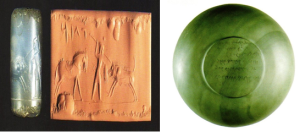
A cup obtained from the palace of the Seton of Persepolis belongs to the year 4 century century 52 BC and a seal from the Achaemenid period or Media، on both of which the samples of the Secretary’s Movement are seen with Iranian names.[xxx]

From right to left، the coins of Ardashir II and the second kings of the Euphrates dynasty of Pars in the 1st century BC with examples of the depicted by the secretary on them.[xxxi]

The above three Dirhams coins belong to Bagdad Shah of Persia، the king who has a material hat and the makeup of his face is also in the style of material، in the second century BC the Shah of Persia. The king’s coins are also seen in the Secretariat.[xxxii]
The unique books of Tajvid science, written in India from 15 to 5 centuries BC, are fortunately to survive. Approximately 200 years after the birth of Zoroastrianism, this science became widespread in Iran and India. The pre-Islamic books such as Kalila and Demne and many parts of the Avesta and hundreds of thousands of handwritten books of the library and University of Gundyshapur in the brutal Turkazzi Arab and Mongol have been lost، but the contents of some of them in Arabic and Persian have been preserved. The first science translated into Arabic to mimic ancient religious practices is the science of Tajwid. It is evident that during the time of Hajjaj ibn Yusuf in Iraq، bloody differences were found among Muslims in reading the Qur’anic verses. In order to prevent the differences between the pilgrims from their Iranian scribes, and it is at this time that the letters of Kufic miracle were adapted from the old lines of Iran and thus the Arabic alphabet was made. The evidence shows that the emergence of this knowledge among Muslims was around 80 AH. The following comparative chart reveals the secret of the root of the Arabic letters.

The diagram above shows the transformation of Avestan Watts into the words of the Hound[xxxiii]
Zabih Behrouz، a great Iranian mathematician، historian and linguist، published a series of articles and books in the beginning of the 20th century، for the first time in 1،000 years، discovered this great secret. A collaborator of Edward Brown، the English Orientalist، since he did not find the linguistic explanations of the time، which have not changed to this day، convincing، he set out to make astonishing discoveries. For him، what was important was the rationality of the alphabet. The logical alphabet reduces the pressure on memory، is quicker to teach، greatly reduces education costs، and teaches children to think logically، especially from early childhood. It creates a social transformation in society، and the way to complete it is logical، not conventional. Zabih Behrooz invented the natural and logical alphabet and the alphabet for children or the child of the teacher and was very successful in teaching natural alphabet to young children aged three or four. He also played a great role in teaching deaf and blind people with inventions including his natural line، and all this is due to the discovery of the secret of the alphabet and the great works of Zoroaster. Therefore، knowing the origins and scientific research in the alphabet is not a purely historical phenomenon، and reopening this secret leads to the knowledge of linguistics and paves the way for the teaching and completion of the alphabet and innovation of the alphabets and the Nora secretaries.
According to the surveys of Iranian and Arab sources mentioned earlier in this article، the Iranians had seven secretaries and scripts before Islam، which therefore are exemplary among all the nations of the world. The variety of these secretaries used for various purposes and the completion and sometimes facilitation of these lines and scientific order that they themselves were aware of the secret of writing. However، the seven lines of ancient Iran in a more correct dialect and using the sources mentioned earlier in this article below:
- Um Dabireh or Ham Dabireh – This line is based on the example of Ibn Nadim in the book of al-Fahrest, as well as the inscriptions and writings in his letters, were less than other Persian scripts because they wrote sounds that have a common denominator with one letter. For example, there was a letter for a, a, a, a letter. The Scriptures were written in the Scriptures, and the Scriptures were written in 28 languages. In the time of Azarkhor that Hamza Esfahani quoted him، many of those methods were forgotten and what they remember. Judgment of the Magistrate and the Magistrate,City Statistics Editorfor City AccountsTreasures of Secretariat Statistics for Treasury Accounts، Statistics Database forCountry Accounts، Statisticsof the Secretary for Accounts of Stables، Statistics of the Secretaryfor Accounts of Fire and Fire Temples، Reports of the Secretary for Accounts of Endowments.
- – Inspector General.28 And they were in the midst of the wicked، and they were in the midst of the wicked. There are many examples of this line on coins، containers، and pacts and bonobiles، among which the famous Bonchub which has been obtained in Oramaan، Kurdistan.In the list of Ibn Nadim two examples of rotation and not rotated from this line can be seen.
- This is the eighth commandment of the Scriptures، and the Scriptures are written in the Scriptures. An example of this line is given in Ibn Nadim’s list and it becomes apparent that there were books of philosophy and ancient medicine in Iran until the end of the fourth century AH.
- The Scriptures were written in the Scriptures، and the Scriptures were written by the Scriptures.
- This line was used to write the secrets of kings and had 40 letters. This is also called the King of Secrets or Secrets of the Veil.
- This unique line which is still one of the most complete alphabets in the world to this day has a letter and has been used to write religious hymns. This line is older than other Iranian lines and according to Ghazi Saed Andalusi and the research of Zabih Behrouz and the documents previously mentioned in this article، it was invented by Zoroaster in the 18th century BC. Other Iranian lines are based on the logic of the religion of the Secretary، and in fact، their letters are either the abstract of the words of the religion of the Dabira or they have been turned and half-turned. Other Iranian lines have emerged from the logic of this line and in later times.
- Visp is the secretary of the whole line and gathers all the lines. With this handwriting، Roman، Coptic، barbarian، Indian، Chinese، Turkish، Nabataean، Arabic، and every sign and every sound، even the sound of the evil of the water. This script has two hundred and five letters for writing the languages of other peoples, and two hundred and five letters for writing inhumane sounds and gestures, or in other words, the professional number of this script was six and five.
Because Iranians were aware of the secrets of their line، they could have multiple lines with fewer and more words. This phenomenon is unique to ancient Iran, and others have not even succeeded in completing their own line.[xxxiv]
Spending on syllables and oral syllables in the books of Tajvid
As mentioned earlier، the alphabet is based on phonetics and phonology based on the cost of syllable letters and cross-section of mouth when pronouncing letters. The knowledge of Tajvid، which has a very ancient root in the history of Iran and India، and the Persian and Arabic translations of those ancient books that have been in Iran and India since the seventeenth centuries BC، have played a major role in opening this secret for Zabih Behrouz. In many of the books of Tajvid، there are twenty-nine or twenty-eight letters، of which seventeen are denominated:
- The 1st، 2nd، and 3rd denominators، which are from the end of the circle to the close of the small tongue، are denominators of six letters: E from the end of the circle، the c and h through the throat and the q from the small tongue.
- The fourth and fifth denominators are the denominators of the small tongue، and from there two letters are spoken: the back of the small tongue and the K on top of the mouth.
- The sixth denominator is the denominator of the air of the mouth, which is the denominator of the letters, and from there three letters are spoken: AHA.
- The seventh is the word of the Lord، and He is the Exalted and the Exalted.
- The eighth is the denominator by the tongue with the belly of the upper molars، whether to the right or the left، from which it is performed.
- The 9th and 11th denominators are the flesh of the teeth of the Sanaya and the quatrains above and beside the tongue، and from there three letters are spoken: L-N-R.
- Twelve and thirteen denominators – These denominators are sharp tongues and high palate areas connected to Sanaya and from there three letters are spoken: d، as well as the sharp head of the tongue and the head of the teeth of the upper incinerators، from which three letters are spoken: Z z.
- 14 And he shall be the one who shall be the Son of man, and the Lamb shall be the Son of man, and the Son of man shall be the Son of man. Three words are said from this denominator: S S.
- Denominator 15 – This denominator is the head of the upper teeth and lower belly abdomen. From there، a letter is pronounced ” F “. In Persian، the letter “and ” is also pronounced from this denominator.
- Denominator 16 This denominator is the same denominator from which three letters are spoken: bm w (“and” in Arabic and “w” in English).[xxxv]
- 17 The denominator is the denominator of the nostril, and that denominator is the denominator of the dweller in the time of Ghana. [xxxvi]
What was mentioned above was the result of the books of Tajvid that Iranians wrote for the Arabs، hence the cost of letters and mouth sections for pronouncing Arabic letters. The original of these books has been burned in Pahlavi language، unfortunately، in the Arab and Mongol sedition. Fortunately، many books in this science have been written in Sanskrit language since the 15th century BC that remain in India to this day. And the Egyptians were all the same as the Arabs.[xxxvii] The Qur’an is the first book of the Qur’an، and the first book of the Qur’an is the first book of the Qur’an.[xxxviii] They taught the ancient Indians and the ancient Tajvid to these ancient people. It is very simple to draw on the principles of the cost of every letter and its corresponding cross-section in the mouth for every language and on this basis we create a universal natural and linear editor for all the languages of the world. This is what Zabih Behrouz did for example for the Persian language and made two natural lines for this language، one was a teacher child for teaching young children and the other was a natural and scientific line based on the cost of syllable letters and oral sections for the Persian language. These two lines originally had a logic and the second line was actually half the first line، and thus this Iranian tradition was also upheld. Below you can see examples of vertical and horizontal images of the mouth، as well as the separate section of the tongue in the books of Tajvid.
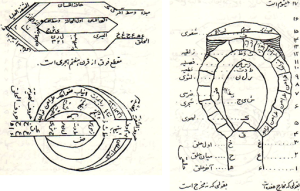
Fill the book with the Scriptures and the Gospel of the Gospel of the Gospel.[xxxix]
Drawing cross-sections for letters of a new alphabet
Zabih Behrouz thought that there was no alphabet and that we wanted to re-establish the perfect alphabet. He created this scientific alphabet for Persian as an example and considered the natural features of the language، although it is possible to generalize it to any language according to its characteristics. The easiest way to create the letters of this alphabet is to see which of the members has an obvious involvement in the pronunciation of a given sound، to draw the cross-section shape of the same member in the pronunciation state for that letter. Zabih Behrouz also knew that it was not easy to pronounce a sound to distinguish its denominator، to determine the obvious and visible member، to draw the shape of the member cross-section، and to select one of the several sections for a given sound. So he first drew a few simple shapes of lips and nasal (nostrils), teeth, tongue, and throat, which are expenditures and producers of sounds. He then gave them a few general instructions about their relationship with sound، and he categorized them as such for the Persian language:[xl]
The first section, the lip--in the figure below eight sections of the lip is depicted. Five different sections of the front and side of the two lips and three sections of the upper lip.

![]()
5 And they shall be brought to the left, and the other shall be made to the left, and the
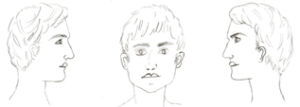

The three upper lip segments respectively are in order to the right to the left to make the sounds of B, p.
The second section, the crucifixion—given in the figure below is a cross section of the nasal cavity or visible nostril.
![]()
- The third section, the tooth—is given in the following five sections of the teeth:
- Two teeth on top (profile):
 two teeth on top (half face) and part of the upper nose:
two teeth on top (half face) and part of the upper nose:  two teeth next to each other (half face):
two teeth next to each other (half face):  one half tooth :
one half tooth :  two teeth side by side (front):
two teeth side by side (front): 
- The fourth section, the lip and the teeth—are given in the following two sections of the lip and the teeth:
- One upper tooth on the lower lip (the silhouette):

- Two upper teeth on the lower lip (front):

- Fifth grade – Language – In the following forms five sections of the language are given:[xli]
- Language from the front:

- Facing the head of the tongue with the head tilted upwards:

- Half-way through the right tongue:

- The tongue is raised from the side of the head.

- The tongue is the opposite of the tongue (the tongue of the tongue).

- Sixth، sixth and sixth of the Scriptures are the words of the Lord. In each of these sections، the top line is the palate and the underline of the language:
- The tongue and the tongue are both parallel and the tongue is dangling.
- Simple steps to teach children:

- More Accurate Section:

- Tongue and tongue in which the tongue is raised.

- Tongue and tongue in the mouth of the tongue.

- The posterior section of the palate with the tongue that is attached to it، and this is the case that the front part of the palate does not affect the sound:

- The palate and the tongue in which the head of the tongue clung to the palate before pronouncing:

- Tongue and palate section in the case of the tongue clinging to the palate before pronunciation with the front tooth profile:

- Verse 7 “And the tongue and the tongue shall be opened، and the tongue shall be opened.”

- 8 The tongue and the teeth are given in the form below the profile of the tongue sticking behind the upper teeth:

- The ninth section, the throat-in the following two combined sections of throat are given:
The tracheal section and a part of the throat of the skew of the hemisphere:
![]()
Crescent section of the throat and small tongue in front of:
![]()
It is worth noting that Zabih Behrouz drew these sections for Persian language and its features، and for other languages many other sections can be drawn. He then showed the relationship between sounds، cross-sections and letters with four main principles:[xlii]
- Principle 1 – Put “A” in front of each letter and pronounce both together and very thick, and hesitate several times to feel the lips, teeth, tongue, etc. to draw approximate the cross-section. ،
- Principle 2 – Any element that is more pronounced in pronunciation of the letter will draw the shape of the same element in the pronunciation mode for the letter.
- Principle 3 – Whenever two or three letters are pronounced with one member، you draw the shape of the member in the pronunciation mode from the front or right or left profile to have different shapes.
- Principle 4: If we can draw for a single letter of several sections، you would prefer the form that is more suitable for writing and close to the letter of one of the normal alphabets of the world and by which the changes of homosexual sounds can be better displayed.
Zabih Behrouz by drawing the nine stages and taking into account his four principles and with many experiments on children and teenagers and various classes of people realized that three types of alphabets are necessary for the teaching of new students and considering the above three types of alphabets Natural And Book and Writing Equal to the table below.
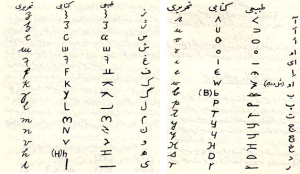
A proposed example of the natural and scientific secretariat, from the Zabih Behrooz.[xliv]
Zabih Behrouz، who originally wanted to make completely new and natural letters using scientific principles and sections، and natural expenses، realized with amazement that the result of the linear work was that many similarities on the one hand with the religion of the old Divine or Avestan line and other Iranian editors and on the other hand with ancient Phoenician and Greek and Latin lines and even many similarities with the Runic line Anglo-Saxony and Russian Cyrillic line and ancient examples of the Golitsa line. It was here that the mystery of the invention of the world’s letter lines was revealed to him based on phonemetic and phonemetics. The logic of all of these lines was the same principles that Zabih Behrouz had used، the same principles that had been mentioned in the books of Iranian and Indian Tajvid، the same principles that the orator and philosopher of ancient Iran، Zoroaster، had brought in the eighteenth century BC. Since he was also a mathematician، he then did extensive research to understand the principles and logic of the invention of numbers and came to surprising and admirable results.
Geometric or Diwani digits
Zabih Behrouz with or Ftan names of numbers in Avestan and Pahlavi language and the way they are written in the religion of Dabireh and Dabireh Pahlavi found that geometric or divan digits used all over the world، the initials of Iranian numbers are from one to nine. Also، “zero” is from the Avestan word “Zafar” meaning ring and is one of the Avestan endowment signs that were sometimes written as rings and sometimes as points. The word “zephyro” means zero, which goes to Europe with geometric digits, is derived from the ancient word zaffar.[xlv]Surprisingly، these numbers are known in Europe and the United States as Arabic numerals. But the Arabs themselves call them Indian numerals، which is an incorrect pronunciation of Iranian geometric digits. Zabih Behrouz’s masterpiece in proving the correctness of his theory is the comparative table below, although he has also considered the initials of numbers in other Iranian languages, including Sogdian.

In the diagram above, the metamorphosis of the numbers (digits) of the initial watts of their names is revealed in Iranian languages.[xlvi]
Now knowing the above we take a glimpse of the imaginary theories of famous linguists such as Isaac Taylor. Surprisingly, these ancient, mythical and unscientific theories of not knowing the logic and principles of alphabet building continue to be taught in universities around the world. Here it is good to repeat the question of the beginning of the article، whether in a world where man sets foot on the moon and in a world that has split the nucleus of an atom، is it so difficult to find logic and the origins of the alphabet or are there other motives that have blocked scientific research، and has ignored the up-to-date theory for half a century and continues to narrate myths. We don’t need to be linguists، but any child with an average IQ will find out the truth by reading this article and its logic and looking at the table that will come later. Renowned linguist Isaac Taylor only because the owl was called “molak” in ancient Egyptian language، the sky and the line were woven together to shave the root of the letter “M”. The art of Isaac Taylor and the longtime linguists of the world’s universities is how they turned the poor owl into an M.[xlvii]
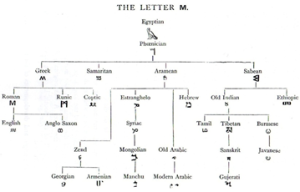
The diagram Isaac Taylor suggests in his well-known book The History of the Alphabet for the root of the letter “M”.[xlviii]
In this scientific research، the author has a larger goal than the purely historical aspects of writing، and hopes that by knowing the secret of writing and logic and its principles، people of various countries who have an illogical and unscientific alphabet or more or less suitable for their language will use these principles to improve and complete and change their alphabets in the future. For example، the illogical alphabet of the beautiful French language and the unreasonable spelling and conventionalism of French vocabulary have closed the way to teaching this beautiful language and high French culture for other people of the world or very difficult. Knowing the secret of writing can revolutionize children’s education، make their talent faster and at a younger age، and ultimately reduce the budgets of education ministries economically. Children who have experienced the natural alphabet، by using this logical alphabet and being raised with logical and natural principles، will have a more creative personality than children who have been trained with the conventional alphabet. The child of Zabih Behrooz، who is based on this natural and logical alphabet، had a lot of acceptance among the children of his classes and it was very easy to teach and accept it by children was very satisfying because the children actually learned the alphabet while playing with their mouths. The natural alphabet can also be used to teach adults، or as an intermediate alphabet to teach other alphabets. The natural alphabet can also play a huge role in educating the blind and deaf. He was a great witness to the blind، and the great things he did in his life.[xlix]
[i] Writing Systems, A linguistic Approach, Henry Rogers, Blackwell Publishing, 2005, p.269
[ii] 271Writing Systems, A linguistic Approach, Henry Rogers, Blackwell Publishing, 2005, p.
[iii] 286Writing Systems, A linguistic Approach, Henry Rogers, Blackwell Publishing, 2005, p.
[iv] Writing Systems, A linguistic Approach, Henry Rogers, Blackwell Publishing, 2005, p111
[v] 264Writing Systems, A linguistic Approach, Henry Rogers, Blackwell Publishing, 2005, p.
[vi] Writing Systems, A linguistic Approach, Henry Rogers, Blackwell Publishing, 2005, p. 271
[vii] 272Writing Systems, A linguistic Approach, Henry Rogers, Blackwell Publishing, 2005,p.
[viii] BMAC (Bactria-Margiana Archaeological Complex)
[ix] Viktor Ivanovich Sarianidi
[x] Gobekli tepe
[xi] Indus Valley Civilisation
[xii] Harappan Civilisation
[xiii] Khat va Farhang, Zabih Behrouz, Forouhar Publications, 1984, Procedures 163 and 164
[xiv] A Sumer Aryan Dictionary, L. Austine Waddel, Kessinger Publishing’s, 1927, p.1
[xv] Khat va Farhang, Zabih Behrouz, Forouhar Publications, 1984, Procedure 170
[xvi] A Sumer Aryan Dictionary, L. Austine Waddel, Kessinger Publishing’s, 1927,
[xvii] The Aryan Origin of The Alphabet, L. A. Waddel, Martino Publishing, 2010
[xviii]www.youtube.com/watch?v=JzKurvnaqWM
[xix] The Phoenician Origin of Britons, Scots and Anglo- Saxons, L. Austine Waddell,Kessinger Publishing’s2008,
[xx] Writing Systems, A linguistic Approach, Henry Rogers, Blackwell Publishing, 2005,p.117
[xxi] Khat va Farhang, Zabih Behrooz, Forouhar Publications, 1984, Procedures 190, 191, 192
[xxii] Calendar and Date in Iran, Zabih Behrouz, Cheshmeh Publication, Tehran, 2008
[xxiii] Khat va Farhang, Zabih Behrooz, Forouhar Publications, 1984, Procedures 134, 135
[xxiv] The fact that the religion of Dabira was used to write religious texts as its name suggests، shows why this line is not in the ancient excavations of this line. With this line only on cowhide and similar materials they wrote religious texts and had another line for coins and utensils, etc.
[xxv] Dabirah, Zabih Behrooz, Forouhar Publications, 1984, 20, 22, 23, 24, 25
[xxvi] The author himself saw it at the Metropolitan Museum in New York.
[xxvii] http://www.iranicaonline.org/articles/persis-kings-of
[xxviii] Geshteh Dabireh, Dr. Sadegh Kia, Iran Koodeh Publications, Rev. 14
[xxix] Forgotton Empire,Edited by John Curtis and Nigel Tallis,The British Museum Press, London, 2005
[xxx] Forgotton Empire,Edited by John Curtis and Nigel Tallis,The British Museum Press, London, 2005,P.161,P.229
[xxxi] http://www.anythinganywhere.com/commerce/coins/coinpics/ancg-persis.htm
[xxxii] Forgotton Empire,Edited by John Curtis and Nigel Tallis,The British Museum Press, London, 2005,P.259
[xxxiii] Dabirah, Zabih Behrouz, Forouhar Publications, 1984, Procedure 47
[xxxiv] Khat va Farhang, Zabih Behrooz, Forouhar Publications, 1984, Procedure 138
[xxxv] The letter “P” is also a denominator of lips.
[xxxvi] Dabirah, Zabih Behrooz, Forouhar Publications, 1984, Procedures 31, 32, 33
[xxxvii] Previously in a comparative table in this article.
[xxxviii] Mu’jjim al-Baldan, Yaghoot al-Hamavi, Dar al-Kutab al-Alamiyyah, Beirut, Lebanon, Vol. III, 1990 CE.
[xxxix] Dabirah, Zabih Behrouz, Forouhar Publications, 1984, Procedures 35, 36
[xl] Dabireh, Zabih Behrouz, Forouhar Publications, 1984, Procedures 10,11,12,13
[xli] A straight line is always the cross-section of the language.
[xlii] Dabireh, Zabih Behrooz, Forouhar Publications, 1984, Procedures 15,16
[xliii] When pronouncing “A” you can open your mouth completely and leave the Persian language free and idle. So when the second letter is pronounced thickly and heavily, the lips and teeth and so on are well felt.
[xliv] Dabirah, Zabih Behrouz, Forouhar Publications, 1984, Procedures 14, 15
[xlv] Dabirah, Zabih Behrooz, Forouhar Publications, 1984, Procedures 54,55
[xlvi] Dabirah, Zabih Behrouz, Forouhar Publications, 1984, Procedure 55
[xlvii] History of the Alphabet: Semitic Alphabets, Part 1,Isaac Taylor,Edward Arnold Publishing, London, 1899,p.9,10,11
[xlviii] History of the Alphabet: Semitic Alphabets, Part 1,Isaac Taylor,Edward Arnold Publishing, London, 1899,p11.
[xlix] Biography، Mood and Thoughts of Zabih Behrooz and His Role in the Education of the Deaf in Iran، Dr. Mohammad Reza Bigdeli، Ministry of Education، 1999
Be the first to write a review
Post Views::
32

- +1 (415) 685 8888
- info@mehriran.tv
-
St. Kilda Road towers level 1, 1 Queens Road Melbourne,
Victoria 3004 Australia
Copyright © MehriranTV 2012 - 2024

